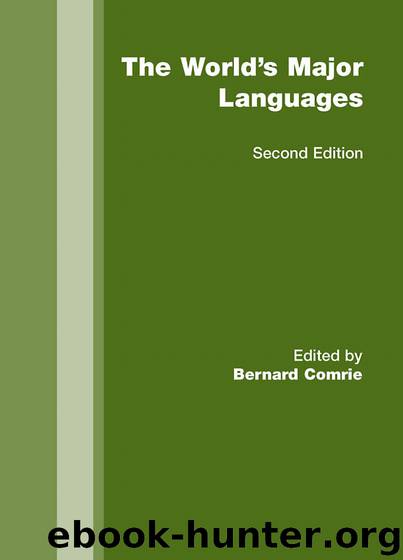The World’s Major Languages by Bernard Comrie

Author:Bernard Comrie [Comrie, Bernard]
Language: eng
Format: mobi, epub
Tags: Humanities
Publisher: Taylor & Francis
Published: 2009-03-19T16:00:00+00:00
5 Concluding Points
In this final section the intention is to relate the foregoing discussion to the question of Bengali's historical development and present standing, both within the Indo-Aryan family and within the general South Asian language area. To accomplish this, it is useful to consider the fact of lectal differentiation in the present community of Bengali speakers. Both vertical and horizontal varieties are observed.
Vertical differentiation, or diglossia, is a feature of the current standard language. This is to say that the language has two styles used more or less for complementary purposes. Of the two styles, the literary or 'pundit language' (sadhu bhasa) shows greater conservatism in word morphology (i.e. in regard to verbal morphophonemics and the shapes of case endings) as well as in lexis (it is characterised by a high frequency of words whose forms are directly borrowed from Sanskrit). The less conservative style identified with the spoken or 'current language' (colti bhasa) is the everyday medium of informal discourse. Lately it is also gaining currency in more formal discourse situations and, in written expression, has been encroaching on the literary style for some decades.
The institutionalisation of the sadhu-colti distinction occurred in Bengali in the nineteenth century, and (as suggested in the last paragraph) shows signs of weakening today. Given (1) that the majority of Bengali speakers today are not Hindu and cannot be expected to maintain an emotional affinity to Sanskritic norms, plus (2) the Bangladesh government's recent moves to enhance the Islamic character of eastern Bengali society and culture and (3) the fact that the colloquial style is overtaking the literary even in western Bengal (both in speech and writing), it remains to be seen over the coming years whether a formal differentiation of everyday versus 'pundit' style language will be maintained.
It should be added that, although throughout the Bengali-speaking area a single, more or less uniform variety of the language is regarded as the standard dialect, the bulk of speakers have at best a passing acquaintance with it. That is, horizontal differentiation of Bengali lects is very extensive (if poorly researched), both in terms of the number of regional dialects that occur and in terms of their mutual divergence. (The extreme eastern dialect of Chittagong, for instance, is unintelligible even to many speakers of other eastern Bengali dialects.) The degree of horizontal differentiation that occurs in the present Bengali-speaking region is related to the ambiguity of Bengali's linguistic affiliation, i.e. areal as contrasted with genetic. It is to be noted that the Bengali-speaking region of the Indian subcontinent to this day borders on or subsumes the domains of a number of non-Indo-Aryan languages. Among them are Malto (a Dravidian language of eastern Bihar); Ahom (a Tai language of neighbouring Assam); Garo (a Tibeto-Burman language spoken in the northern districts of Bengal itself); as well as several languages affiliated with Munda (a subfamily of Austro-Asiatic), such as Santali and Mundari (both of these languages are spoken within as well as outside the Bengali-speaking area).
It has been
Download
The World’s Major Languages by Bernard Comrie.epub
This site does not store any files on its server. We only index and link to content provided by other sites. Please contact the content providers to delete copyright contents if any and email us, we'll remove relevant links or contents immediately.
The Secret History by Donna Tartt(16610)
Red Sparrow by Jason Matthews(4654)
Harry Potter 02 & The Chamber Of Secrets (Illustrated) by J.K. Rowling(3289)
In a Sunburned Country by Bill Bryson(2941)
Figure Drawing for Artists by Steve Huston(2792)
The Daily Stoic by Holiday Ryan & Hanselman Stephen(2703)
Drawing Cutting Edge Anatomy by Christopher Hart(2671)
The Roots of Romanticism (Second Edition) by Berlin Isaiah Hardy Henry Gray John(2565)
Japanese Design by Patricia J. Graham(2552)
Make Comics Like the Pros by Greg Pak(2421)
Stacked Decks by The Rotenberg Collection(2266)
Harry Potter and the Deathly Hallows (7) by J.K. Rowling(2213)
On Photography by Susan Sontag(2127)
Draw-A-Saurus by James Silvani(2102)
Tattoo Art by Doralba Picerno(2079)
Foreign Devils on the Silk Road: The Search for the Lost Treasures of Central Asia by Peter Hopkirk(2053)
The Traveler's Gift by Andy Andrews(2008)
Churchill by Paul Johnson(2006)
Drawing and Painting Birds by Tim Wootton(1997)
